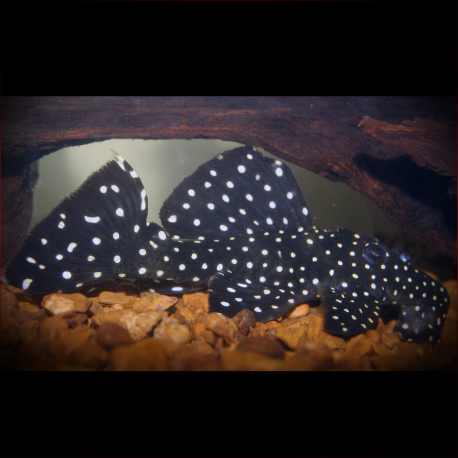More info
Datasheet
| Minimum Tank Size | 243 litres / 64.19 US gallons |
| Maximum Size | 25.0cm / 9.84inches |
| Temperature | 22°C / 71.60°F - 26°C / 78.80°F |
| Hardness | 0-10ºdH |
| pH | 5.6-7.0 |
General Description
Known commonly as the Galaxy Plec or L029, the Leporacanthicus Galaxias is a striking plec with unique features, often referred to as the vampire or tusken plec due to distinctive morphological attributes. Members of this species possess a characteristic growth on their head and dentition with two prominent teeth, possibly used for gripping prey such as snails.
Aquarium Setup
For optimal care of L. galaxias, a spacious tank (minimum 243 litres) with sandy substrate, ample hiding spots using driftwood and rocks, dim lighting, and well-oxygenated water with some flow is recommended. Efficient filtration is crucial due to their significant waste output. Water conditions should be maintained within a pH range of 5.6-7.0, hardness of 0-10 dH, and a temperature of 22-26°C (see table).
Behaviour
Galaxy Plecs are generally peaceful towards other tank inhabitants, particularly thriving alongside larger characins, reophilic cichlids, and other Loricariids in appropriate biotope setups. They can exhibit territorial behavior towards benthic species with similar color patterns, requiring spacious accommodations when housed in groups.
Feeding and Diet
While not strictly vegetarian, L. galaxias accepts sinking dried foods and enjoys meatier treats like earthworms, prawns, mussels, bloodworms, and snails. This species demonstrates a versatile palate compared to other Loricariids.
Reproduction & Dimorphism
Details regarding the breeding of L. galaxias are scarce, but it is known to spawn in deep riverbank crevices during the wet season. Mature males display sexual dimorphism with wider heads, larger dorsal fins, and more numerous odontotes compared to females.
Habitat and Distribution
Native to various river basins in Brazil, including the Amazon and Tocantins, L. galaxias is a reophilic species adapted to rapids and fast-flowing waters. Maintaining suitable water parameters and habitat conditions in captivity is essential for their overall well-being.

